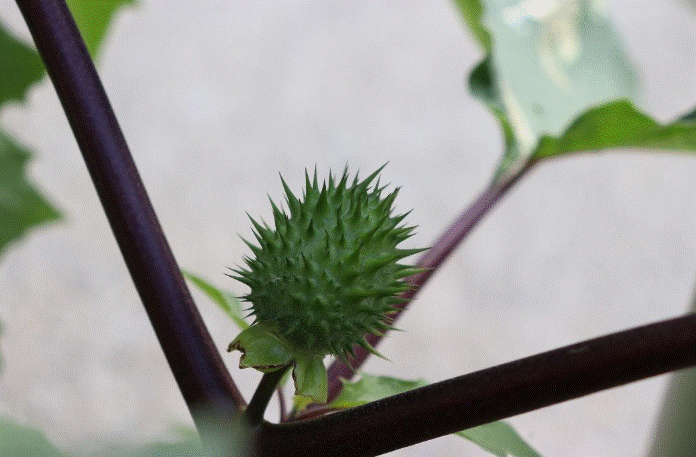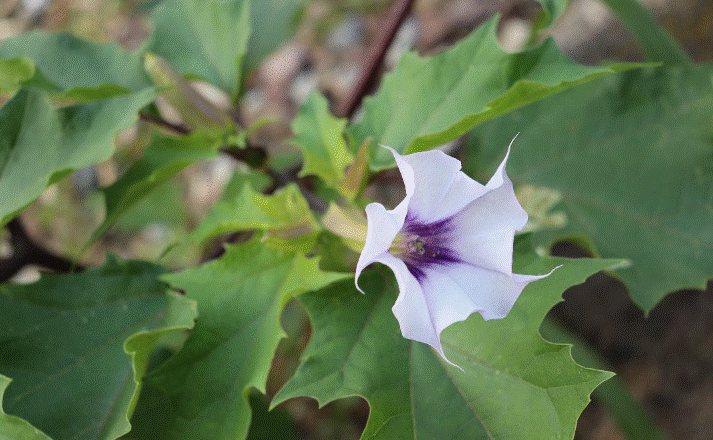By Bob Confer
Jimsonweed is an invasive species from Central America that was brought to North America hundreds of years ago and has been spreading slowly but surely. Through the 1900s it was an uncommon if not rare find in Western New York. But, it has become more abundant over the past twenty years.
It is a plant that has quite the dark history behind it, and it can be deadly – which is why it ends up in the crosshairs of landowners and municipalities that want to keep the spreading plant at bay.
This column will address the plant’s dangers so you are aware of what might be lurking in your hedgerow.
Finding and identifying jimsonweed
Jimsonweed starts to make its appearance in late-August and early-September. It will grow quite well, and rather quickly, becoming a large, bushy weed that can max out at 4 feet in height and width. It frequents fields, barnyards, and places that naturalists classify as waste areas (brownfields, rail beds, newly turned soils, etc).

It is a unique, unmistakable plant that immediately catches your attention. It has a stout, deep green, sometimes purplish stem, with numerous irregularly-lobed leaves that can be up to 8 inches long. The flowers are fairly large and trumpet shaped (that trumpet is often folded shut). Some plants will sport white flowers while others will have violet ones. Throughout the late-summer and fall, the jimsonweed will hold large, spiky seedpods that will gradually open and expose dozens of black seeds the size of BBs.
It is those numerous, hardy seeds that can cause jimsonweed to take over an area once the first plant appears. If you don’t kill the initial plant before the seed pods ripen, those seeds will make their appearance next year and what was one plant will be a dozen of them within a few inches or a few feet of the mother plant. Within a few years, an area can be choked by the plants.
Some people let those colonies grow wild. After all, the plants are attractive in their own way.
If you do that you’ve really got to gauge the risk associated with it as you may be playing with fire if you have kids or farm animals.
Jimsonweed is a deadly hallucinogen
Jimsonweed is one of the most vicious naturally-occurring hallucinogens in North America. Not only will it create powerful, uncomfortable hallucinations, its consumption can also lead to death, which is why even drug users won’t even touch the stuff – while cocaine and meth might kill them gradually, jimsonweed can kill them with relative immediacy.
Unfortunately, that has not stopped teens from experimenting with jimsonweed.
Here in the United States, where it is not a controlled substance, there are approximately 900 jimsonweed poisonings every year. I remember hearing of one group of teenagers who toyed with it in Arizona a few years ago. One boy thought his body was covered with spiders while his friend thought he lost all of his limbs. They remained in such a state for a few days and stayed in hospital for a week and were lucky that their doctors were able to keep them alive.
In Canada, they have had a rash of situations this century as the plant continues its northward spread. Look as these disturbing reports, all from Ontario:
- In 2000, a St. Catharines teen died from eating Jimsonweed leaves
- In 2005, more than a dozen Toronto high school students were hospitalized after eating the seeds
- In 2007, 3 boys, aged 14 to 17, in Hamilton went into incoherent, unresponsive states that lasted for days
- Then, in 2014, despite all of that recent history, a handful of Ottawa teens were hospitalized after nibbling on the plants on a dare

Anyone who survived the weed is lucky. It can kill because it blocks major neurotransmitters in the brain which lead to a loss of voluntary and involuntary functions. Symptoms of jimsonweed poisoning include inability to urinate, double vision, slurred speech, heartbeat abnormalities, increased body temperature, difficulty breathing, convulsions, and coma. It’s not a pretty death as the body painfully shuts down piece by piece.
Little children have been known to die from it after innocently picking at the seed pods and eating the seeds. Cattle, sheep, and goats will also die from eating the plants.
That’s why it is strongly suggested you kill the plant when you see it. And, you should wear gloves when doing so – some people are susceptible to the plant juices and will get a rash when handling it.
The history of jimsonweed
Jimsonweed got its name as a mutilation of the name “Jamestown Weed.” In 1676 a detachment of British troops was dispatched to Jamestown, Virginia to handle its residents. Near the settlement, the soldiers ran out of their rations so they boiled jimsonweed, thinking it was edible. Had they not boiled it, they surely would have died. Instead, they went absolutely nuts for a week and a half. In a historical report prepared in 1705, it was said that it was…
“…a very pleasant comedy, for they turned natural fools upon it for several days: one would blow up a feather in the air; another would dart straws at it with much fury; and another, stark naked, was sitting up in a corner like a monkey, grinning and making mows at them; a fourth would fondly kiss and paw his companions, and sneer in their faces with a countenance more antic than any in a Dutch droll.
In this frantic condition they were confined, lest they should, in their folly, destroy themselves — though it was observed that all their actions were full of innocence and good nature. Indeed they were not very cleanly; for they would have wallowed in their own excrements, if they had not been prevented. A thousand such simple tricks they played, and after 11 days returned themselves again, not remembering anything that had passed.”
Jimsonweed has a long history of medical uses and abuses. Among them, the Algonquin Indians used it as the primary ingredient to wysoccan, which was a hallucinogenic blend that boys took on the path to manhood. They were forced to ingest it over a 20 day period spent being violently deranged, coming out of it so ruined that they even forgot their childhood.
Other societies, when making ritualistic killings for their Gods, gave jimsonweed to the person to be sacrificed. I guess it made it easier to kill someone who was insane.
Jimsonweed was also a critical component of European witchcraft and spell casting. It may have even led to the belief that witches fly, because inhaling jimsonweed smoke caused many people to have the sensation of flight.
While I find jimsonweed to be an incredibly interesting plant, a real conversation starter, it’s in the best interest of most that it be destroyed if it appears on your property. It’s dangerous. Someone or some animal could purposely or accidentally ingest it, resulting in frightening hallucinations and death. Be careful.







